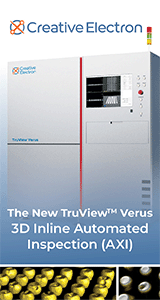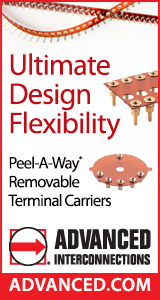| Sponsor |

|
Need a Profiler Plan B?
Tired of having to share a thermal profiler across different soldering operations? Add the affordable V-M.O.L.E. 2 four-channel profiler to the mix for time-saving efficiency.
ECD
|
|
How to Manage Material Outgassing in Reflow Oven
This study investigates the evaporation of chemicals during the reflow process from preheating until cooling. Different solder pastes are compared.
Analysis Lab
DOWNLOAD
|
Authored By:
Gerjan Diepstraten
Vitronics Soltec B.V.
Oosterhout, Netherlands
Summary
In a lead-free reflow process, temperatures are higher, and materials use outgasses more than in a leaded reflow process. The trends toward higher density populated boards and more pin-in-paste technology also increase solder paste use. More components and more solder paste result in more outgassing of chemistry during the reflow process. Some assemblies report condensation of vapors when the cold printed circuit board enters the oven. Little is known about the interaction between these condensed materials in terms of the interaction between these condensed materials and the reliability of the assembly. Apart from the question of reliability, a printed circuit board contaminated with a small film of residues after reflow soldering is not desirable.
This study investigates the evaporation of chemicals during the reflow process from preheating until cooling. Different solder pastes are compared with respect to outgassing. Residues collected in the reflow process were submitted to Thermal Desorption-Gas Chromatography-Mass Spectrometry (TDGMS) to determine which volatile and semi-volatile substances the residues contained. A test vehicle was made to investigate if these gasses could be eliminated using a catalyst. After a successful investigation, these catalysts were installed in reflow ovens on individual zones and in those areas where the most outgassing was determined. Different catalysts and solder pastes, chain lubricants, and other materials were part of the study.
Conclusions
The experiments showed that the solder paste has different chemistries that evaporate primarily in soak and peak zones of the oven. A small part (5% or less) condenses in the cooling and is critical for maintenance. The composition of the residues is a mixture of solder mask and paste materials.
In the heating zones, catalysts can significantly reduce fumes and chemical contamination by cracking the molecules of solder paste and solder mask.
Pin-in paste soldering is more often applied and requires significantly more solder paste to have all the barrels filled with solder paste. Assemblies have more solder paste. Applications are observed that contains about 10 times more solder paste for this application. Having all zones fit with a catalyst the fumes in the oven can be minimized.
Initially Published in the SMTA Proceedings
|
Comments
|
No comments have been submitted to date.
|
|
|
|
| Sponsor |

|
e-media Advertising Delivers Results!
Introduce your technology, new products or services in our e-mail newsletter & website to see how a digital advertising campaign can deliver results. Reach over 125,000 professionals.
Circuitnet Media LLC
|
|
|




